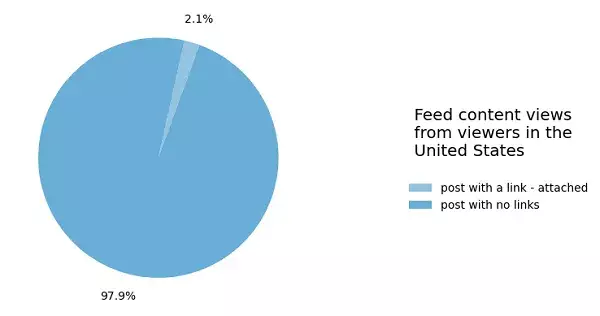Meta, the parent company of Facebook, recently released its Q4 2024 overview outlining content violations, engagement patterns, and hacking incidents. The report serves as a vibrant snapshot of user engagement on Facebook, illustrating the complex interplay between content visibility and adherence to platform policies. The insights present an opportunity to delve deeper into the implications for users, publishers, and the media landscape.
One of the most striking revelations from the latest Widely Viewed Content report is the escalating trend of Facebook posts that lack links to outside sources. The percentage of such posts has soared to a staggering 97.9% in Q4 2024, compared to just 86.5% in Q3 2021. This dramatic shift poses significant challenges for publishers seeking to generate traffic through social media referrals.
The implications are twofold. Firstly, this environment has rendered it increasingly difficult for content creators and journalists to drive organic traffic through Facebook. As the platform increasingly prioritizes internal content over external sources, audiences are finding themselves caught in a loop of insular information that flows within Facebook rather than being exposed to diverse viewpoints and narratives. Secondly, this data raises valid concerns about information silos and the lack of cross-platform engagement, which could foster echo chambers wherein users are only exposed to content aligning with their beliefs or interests.
The report further highlights the types of posts gaining traction on the platform, which tend to lean toward sensationalism, nostalgia, and celebrity-driven narratives. The most viewed content from Q4 2024 included cliched holiday stories and viral moments — a trend showing that emotional connection, even if superficial, drives engagement. Noteworthy mention includes posts such as a child aspiring for Santa to help his mother rather than seeking toys, showcasing the tug of heartstrings over substantive discourse.
This fascination with fluff and celebrity culture raises critical questions about the value of content on social media. If resonating on platforms like Facebook hinges on trivial, sugary narratives rather than well-researched and informative material, is the social media landscape inadvertently devaluing the quality of journalism? For content creators, this information serves as a wake-up call to recalibrate their approach, focusing on engaging narratives while navigating the tenuous limits set by the platform’s algorithms.
Interestingly, the report noted minimal spikes in rule violations during the quarter. However, a concerning uptick in instances of Violent and Graphic Content on Instagram due to updates in Meta’s “proactive detection technology” cannot be overlooked. Meta’s attempts to address problematic content are contradictory at best, indicating ongoing challenges in maintaining a safe and constructive online environment.
Furthermore, the prevalence of fake accounts has been revised down to approximately 3% of worldwide monthly active users (MAUs) on Facebook. While this figure may foster a sense of confidence in Meta’s detection methods, it also raises critical questions regarding data integrity and transparency. Decreasing the percentage could merely reflect a change in measurement rather than an actual improvement in account verification processes.
Most notably, the adoption of a Community Notes model while withdrawing third-party fact-checking invites scrutiny. The purported benefits of fewer enforcement mistakes results in a superficial win unless actual enforcement mechanisms and their accountability remain robust. Meta’s commitment to decreasing erroneous bans, while seemingly positive, invites skepticism regarding whether this reduction comes at the expense of legitimate enforcement actions.
The report also sheds light on external threats, most notably through the identification of influence operations traced back to Russia. Meta noted a particular operation, “Doppleganger,” halting its targeting of the U.S. and Ukraine but continuing to operate in Germany, France, and Israel.
This shift presents an alarming trend of evolving tactics in information warfare, where geopolitical events may dictate the focus of influence campaigns. The apparent withdrawal of Russian operators from direct interference in U.S. affairs suggests a strategic reassessment, possibly influenced by recent events, including elections. Such developments highlight the importance of vigilance and adaptability by social media companies to safeguard democratic processes amid shifting digital threats.
The insights gleaned from Meta’s Q4 2024 report provide a multifaceted view of current trends in social media, revealing both challenges and opportunities. The decline in external linking emphasizes the need for content creators to rethink strategies, while the popularity of trivial content illustrates the continual struggle for substantive discourse. Moreover, issues surrounding content moderation and influences from malicious actors underscore the responsibilities of companies like Meta in preserving a healthy information ecosystem.
Navigating the multifarious dynamics of social media today necessitates a conscious effort from all stakeholders—platforms, content creators, and users alike—to foster a richer, more engaged online dialogue.

